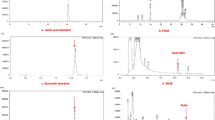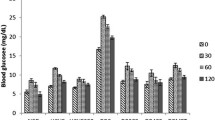Abstract
Purpose
Individuals with metabolic syndrome (MS) show several metabolic abnormalities including insulin resistance, dyslipidaemia, and oxidative stress (OS). Diet is one of the factors influencing the development of MS, and current nutritional advice emphasises the benefits of fruit and vegetable consumption. Here, we assessed the effects of naturally occurring antioxidants, red wine polyphenols (RWPs), on MS and OS.
Methods
Wistar rats (n = 20) weighing 200–220 g received a high-fat diet (HFD) for 2 months before they were divided into two groups that received either HFD only or HFD plus 50 mg/kg RWPs in their drinking water for an additional 2 months. A control group (n = 10) received a normal diet (ND) for 4 months.
Results
Rats receiving HFD increased body weight over 20 % throughout the duration of the study. They also showed increased blood levels of C-peptide, glucose, lipid peroxides, and oxidised proteins. In addition, the HFD increased OS in hepatic, pancreatic, and vascular tissues, as well as induced pancreatic islet cell hyperplasia and hepatic steatosis. Addition of RWPs to the HFD attenuated these effects on plasma and tissue OS and on islet cell hyperplasia. However, RWPs had no effect on blood glucose levels or hepatic steatosis.
Conclusions
RWPs showed an antioxidant mechanism of action against MS. This result will inform future animal studies exploring the metabolic effects of RWPs in more detail. In addition, these findings support the use of antioxidants as adjunctive nutritional treatments for patients with diabetes.




Similar content being viewed by others
References
World Health Organization (1999) Definition, diagnosis and classification of diabetes mellitus and its complications. WHO/NCD/NCS/99.2
Expert Panel on Detection, Evaluation, and Treatment of High Blood Cholesterol in Adults (2001) Executive summary of the third report of the National Cholesterol Education Program (NCEP) Expert Panel on detection, evaluation and treatment of high blood cholesterol in adults (Adults Treatment panel III). JAMA 285:2486–2497
Dunstan DW, Zimmet PZ, Welborn TA, De Courten MP, Cameron AJ, Sicree RA, Dwyer T, Colagiuri S, Jolley D, Knuiman M, Atkins R, Shaw JE (2002) The rising prevalence of diabetes and impaired glucose tolerance: the Australian Diabetes, Obesity and Lifestyle Study. Diabetes Care 25:829–834
Isomaa B, Almgren P, Tuomi T, Forsén B, Lahti K, Nissén M, Taskinen MR, Groop L (2001) Cardiovascular morbidity and mortality associated with the metabolic syndrome. Diabetes Care 24:683–689
Liebman M, Pelican S, Moore SA, Holmes B, Wardlaw MK, Melcher LM, Liddil AC, Paul LC, Dunnagan T, Haynes GW (2003) Dietary intake, eating behavior, and physical activity-related determinants of high body mass index in rural communities in Wyoming, Montana, and Idaho. Int J Obes Relat Metab Disord 27:684–692
Wild SH, Byrne CD (2006) ABC of obesity. Risk factors for diabetes and coronary heart disease. BMJ 333:1009–1011
Araujo FB, Barbosa DS, Hsin CY, Maranhão RC, Abdalla DS (1995) Evaluation of oxidative stress in patients with hyperlipidemia. Atherosclerosis 117:61–71
Kyselová P, Zourek M, Rusavý Z, Trefil L, Racek J (2002) Hyperinsulinemia and oxidative stress. Physiol Res 51:591–595
Yang RL, Shi YH, Hao G, Li W, Le GW (2008) Increasing oxidative stress with progressive hyperlipidemia in human: relation between malondialdehyde and atherogenic index. J Clin Biochem Nutr 43:154–158
Sies H (1991) Oxidative stress: from basic research to clinical application. Am J Med 91:31S–38S
Krieger-Brauer HI, Kather H (1992) Human fat cells possess a plasma membrane-bound H2O2-generating system that is activated by insulin via a mechanism bypassing the receptor kinase. J Clin Invest 89:1006–1013
Kashiwagi A, Shinozaki K, Nishio Y, Maegawa H, Maeno Y, Kanazawa A, Kojima H, Haneda M, Hidaka H, Yasuda H, Kikkawa R (1999) Endothelium-specific activation of NAD(P)H oxidase in aortas of exogenously hyperinsulinemic rats. Am J Physiol 277:E976–E983
Xu L, Badr MZ (1999) Enhanced potential for oxidative stress in hyperinsulinemic rats: imbalance between hepatic peroxisomal hydrogen peroxide production and decomposition due to hyperinsulinemia. Horm Metab Res 31:278–282
Montani JP, Carroll JF, Dwyer TM, Antic V, Yang Z, Dulloo AG (2004) Ectopic fat storage in heart, blood vessels and kidneys in the pathogenesis of cardiovascular diseases. Int J Obes Relat Metab Disord 28(Suppl 4):S58–S65
Guichard C, Moreau R, Pessayre D, Epperson TK, Krause KH (2008) NOX family NADPH oxidases in liver and in pancreatic islets: a role in the metabolic syndrome and diabetes? Biochem Soc Trans 36:920–929
Creager MA, Lüscher TF, Cosentino F, Beckman JA (2003) Diabetes and vascular disease: pathophysiology, clinical consequences, and medical therapy: part I. Circulation 108:1527–1532
Samuel VT, Liu ZX, Qu X, Elder BD, Bilz S, Befroy D, Romanelli AJ, Shulman GI (2004) Mechanism of hepatic insulin resistance in non-alcoholic fatty liver disease. J Biol Chem 279:32345–32353
Visser ME, Lammers NM, Nederveen AJ, van der Graaf M, Heerschap A, Ackermans MT, Sauerwein HP, Stroes ES, Serlie MJ (2011) Hepatic steatosis does not cause insulin resistance in people with familial hypobetalipoproteinaemia. Diabetologia 54:2113–2121
Hamaguchi M, Kojima T, Takeda N, Nakagawa T, Taniguchi H, Fujii K, Omatsu T, Nakajima T, Sarui H, Shimazaki M, Kato T, Okuda J, Ida K (2005) The metabolic syndrome as a predictor of nonalcoholic fatty liver disease. Ann Intern Med 143:722–728
Forbes JM, Cooper ME (2013) Mechanisms of diabetic complications. Physiol Rev 93:137–188
Escribano O, Guillén C, Nevado C, Gómez-Hernández A, Kahn CR, Benito M (2009) Beta-cell hyperplasia induced by hepatic insulin resistance: role of a liver-pancreas endocrine axis through insulin receptor A isoform. Diabetes 58:820–828
Schini-Kerth VB, Etienne-Selloum N, Chataigneau T, Auger C (2011) Vascular protection by natural product-derived polyphenols: in vitro and in vivo evidence. Planta Med 77:1161–1167
Sarr M, Chataigneau M, Martins S, Schott C, El Bedoui J, Oak MH, Muller B, Chataigneau T, Schini-Kerth VB (2006) Red wine polyphenols prevent angiotensin II-induced hypertension and endothelial dysfunction in rats: role of NADPH oxidase. Cardiovasc Res 71:794–802
Dal-Ros S, Bronner C, Auger C, Schini-Kerth VB (2012) Red wine polyphenols improve an established aging-related endothelial dysfunction in the mesenteric artery of middle-aged rats: role of oxidative stress. Biochem Biophys Res Commun 419:381–387
Dal-Ros S, Zoll J, Lang AL, Auger C, Keller N, Bronner C, Geny B, Schini-Kerth VB (2011) Chronic intake of red wine polyphenols by young rats prevents aging-induced endothelial dysfunction and decline in physical performance: role of NADPH oxidase. Biochem Biophys Res Commun 404:743–749
Charles AL, Meyer A, Dal-Ros S, Auger C, Keller N, Ramamoorthy TG, Zoll J, Metzger D, Schini-Kerth V, Geny B (2013) Polyphenols prevent ageing-related impairment in skeletal muscle mitochondrial function through decreased reactive oxygen species production. Exp Physiol 98:536–545
Agouni A, Lagrue-Lak-Hal AH, Mostefai HA, Tesse A, Mulder P, Rouet P, Desmoulin F, Heymes C, Martínez MC, Andriantsitohaina R (2009) Red wine polyphenols prevent metabolic and cardiovascular alterations associated with obesity in Zucker fatty rats (Fa/Fa). PLoS One 4:e5557
Auberval N, Dal S, Bietiger W, Pinget M, Jeandidier N, Maillard-Pedracini E, Schini-Kerth V, Sigrist S (2014) Metabolic and oxidative stress markers in Wistar rats after 2 months on a high-fat diet. Diabetol Metab Syndr 6:130
Auberval N, Dal S, Bietiger W, Seyfritz E, Peluso J, Muller C, Zhao M, Marchioni E, Pinget M, Jeandidier N, Maillard E, Schini-Kerth V, Sigrist S (2015) Oxidative stress type influences the properties of antioxidants containing polyphenols in RINm5F beta cells. Evid Based Complement Altern Med 2015:859048
Bradford MM (1976) A rapid and sensitive method for the quantitation of microgram quantities of protein utilizing the principle of protein-dye binding. Anal Biochem 72:248–254
Gustavsson C, Yassin K, Wahlström E, Cheung L, Lindberg J, Brismar K, Ostenson CG, Norstedt G, Tollet-Egnell P (2010) Sex-different hepaticglycogen content and glucose output in rats. BMC Biochem 11:38
Kleiner DE, Brunt EM, Van Natta M, Behling C, Contos MJ, Cummings OW, Ferrell LD, Liu YC, Torbenson MS, Unalp-Arida A, Yeh M, McCullough AJ, Sanyal AJ, Nonalcoholic Steatohepatitis Clinical Research Network (2005) Design and validation of a histological scoring system for nonalcoholic fatty liver disease. Hepatology 41:1313–1321
Erejuwa OO (2012) Management of diabetes mellitus: could simultaneous targeting of hyperglycemia and oxidative stress be a better panacea? Int J Mol Sci 13:2965–2972
Reagan-Shaw S, Nihal M, Ahmad N (2008) Dose translation from animal to human studies revisited. FASEB J 22(3):659–661
Feillet-Coudray C, Sutra T, Fouret G, Ramos J, Wrutniak-Cabello C, Cabello G, Cristol JP, Coudray C (2009) Oxidative stress in rats fed a high-fat high-sucrose diet and preventive effect of polyphenols: involvement of mitochondrial and NAD(P)H oxidase systems. Free Radic Biol Med 46:624–632
Lee SJ, Choi SK, Seo JS (2009) Grape skin improves antioxidant capacity in rats fed a high fat diet. Nutr Res Pract 3:279–285
Hanhineva K, Törrönen R, Bondia-Pons I, Pekkinen J, Kolehmainen M, Mykkänen H, Poutanen K (2010) Impact of dietary polyphenols on carbohydrate metabolism. Int J Mol Sci 11:1365–1402
Li JM, Wang W, Fan CY, Wang MX, Zhang X, Hu QH, Kong LD (2013) Quercetin preserves β-cell mass and function in fructose-induced hyperinsulinemia through modulating pancreatic Akt/FoxO1 activation. Evid Based Complement Altern Med 2013:303902
Aoun M, Michel F, Fouret G, Casas F, Jullien M, Wrutniak-Cabello C, Ramos J, Cristol JP, Coudray C, Carbonneau MA, Feillet-Coudray C (2010) A polyphenol extract modifies quantity but not quality of liver fatty acid content in high-fat-high-sucrose diet-fed rats: possible implication of the sirtuin pathway. Br J Nutr 104:1760–1770
Bahadoran Z, Mirmiran P, Azizi F (2013) Dietary polyphenols as potential nutraceuticals in management of diabetes: a review. J Diabetes Metab Disord 12:43
Muller CJ, Fugelsang KC (1997) Red wine but not white: the importance of fully characterizing wines used in health studies. Am J Clin Nutr 66:447–451
Menaa F, Badole S, Menaa B, Menaa A, Badhankar SL (2012) Polyphenols, promising therapeutics for inflammatory diseases? In: Watson RR, Preedy V (eds) Bioactive food as dietary interventions for arthritis and related inflammatory diseases, bioactive food in chronic disease states, 1st edn. Academic Press, Cambridge, pp 421–428
Ueda M, Hayashibara K, Ashida H (2013) Propolis extract promotes translocation of glucose transporter 4 and glucose uptake through both PI3 K- and AMPK-dependent pathways in skeletal muscle. BioFactors 39:457–466
Acknowledgments
The authors would like to express their gratitude to the foundation “Vaincre le Diabète” and ASDIA (Assistance Service Diabète) for funding this project.
Author information
Authors and Affiliations
Corresponding author
Ethics declarations
Conflict of interest
The authors declare that they have no conflict of interest.
Rights and permissions
About this article
Cite this article
Auberval, N., Dal, S., Maillard, E. et al. Beneficial effects of a red wine polyphenol extract on high-fat diet-induced metabolic syndrome in rats. Eur J Nutr 56, 1467–1475 (2017). https://doi.org/10.1007/s00394-016-1192-2
Received:
Accepted:
Published:
Issue Date:
DOI: https://doi.org/10.1007/s00394-016-1192-2




